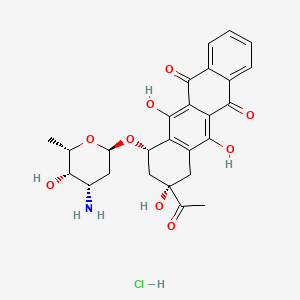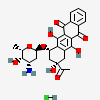Idarubicin Hydrochloride
- idarubicin hydrochloride
- Idarubicin Hcl
- 57852-57-0
- Idamycin
- Zavedos
- Create:2005-06-24
- Modify:2025-01-18
 Idarubicin (has active moiety).
Idarubicin (has active moiety).
- 4 Demethoxydaunorubicin
- 4 Desmethoxydaunorubicin
- 4-Demethoxydaunorubicin
- 4-Desmethoxydaunorubicin
- Hydrochloride, Idarubicin
- Idarubicin
- Idarubicin Hydrochloride
- IMI 30
- IMI-30
- IMI30
- NSC 256439
- NSC-256439
- NSC256439
- idarubicin hydrochloride
- Idarubicin Hcl
- 57852-57-0
- Idamycin
- Zavedos
- Idarubicin (hydrochloride)
- Idamycin PFS
- IMI 30
- UNII-5VV3MDU5IE
- 5VV3MDU5IE
- Idarubicin hydrochloride PFS
- IMI-30
- DTXSID0047797
- EINECS 260-990-7
- 4-Demethoxydaunorubicin hydrochloride
- CPD000466355
- DTXCID0027775
- MLS001401448
- NSC-256439
- Daunomycin, 4-demethoxy-, hydrochloride
- Idarubicin hydrochloride [USAN:USP:INN]
- SMR000466355
- IDARUBICIN HYDROCHLORIDE (MART.)
- IDARUBICIN HYDROCHLORIDE [MART.]
- IDARUBICIN HYDROCHLORIDE (USP-RS)
- IDARUBICIN HYDROCHLORIDE [USP-RS]
- (7S,9S)-9-acetyl-7-(((2R,4S,5S,6S)-4-amino-5-hydroxy-6-methyltetrahydro-2H-pyran-2-yl)oxy)-6,9,11-trihydroxy-7,8,9,10-tetrahydrotetracene-5,12-dione hydrochloride
- 5,12-Naphthacenedione, 9-acetyl-7-((3-amino-2,3,6-trideoxy-alpha-L-lyxo-hexopyranosyl)oxy)-7,8,9,10-tetrahydro-6,9,11-trihydroxyhydrochloride, (7S-cis)-
- Idarubicin hydrochloride (USAN:USP:INN)
- CAS-57852-57-0
- IDARUBICIN HYDROCHLORIDE (USP MONOGRAPH)
- IDARUBICIN HYDROCHLORIDE [USP MONOGRAPH]
- NSC 256439
- NCGC00093976-03
- SR-01000075934
- Idamycin (TN)
- MFCD00897212
- DMDR
- Idarubicin hydrochlorid
- Idarubicin hydrochloride?
- Hydrochloride, Idarubicin
- (7S,9S)-9-acetyl-7-[(2R,4S,5S,6S)-4-amino-5-hydroxy-6-methyloxan-2-yl]oxy-6,9,11-trihydroxy-8,10-dihydro-7H-tetracene-5,12-dione;hydrochloride
- (7S-cis)-9-Acetyl-7-[(3-amino-2,3,6-trideoxy-alpha-L-lyxo-hexopyranosyl)oxy]-7,8,9,10-tetrahydro-6,9,11-trihydroxy-5,12-naphthacenedione
- SCHEMBL4838
- MLS000759470
- CHEMBL1200976
- CHEBI:31686
- JVHPTYWUBOQMBP-RVFAQHLVSA-N
- KUC110342C
- EX-A1148
- Tox21_111236
- HY-17381R
- IDARUBICIN HYDROCHLORIDE [MI]
- MFCD00866457
- s1228
- Idarubicin hydrochloride (JP18/USP)
- IDARUBICIN HYDROCHLORIDE [JAN]
- AKOS025402118
- Idarubicin (hydrochloride) (Standard)
- Tox21_111236_1
- AC-5255
- CCG-100886
- CS-1061
- IDARUBICIN HYDROCHLORIDE [USAN]
- NC00136
- IDARUBICIN HYDROCHLORIDE [VANDF]
- IDARUBICIN HYDROCHLORIDE [WHO-DD]
- NCGC00093976-08
- (1S,3S)-3-Acetyl-1,2,3,4,6,11-hexahydro-3,5,12-trihydroxy-6,11-dioxo-1-naphthacenyl 3-amino-2,3,6-trideoxy-alpha-L-lyxo-hexopyranoside, hydrochloride
- AS-75944
- HY-17381
- KSC-230-185-1
- Idarubicin Hydrochloride (1mg/mL in DMSO)
- NS00087283
- IDARUBICIN HYDROCHLORIDE [ORANGE BOOK]
- D01747
- Q-101407
- SR-01000075934-5
- Q27262943
- (2S,4S)-2-Acetyl-4-(3-amino-2,3,6-trideoxy-alpha-L-lyxo-hexopyranosyloxy)-2,5,12-trihydroxy-1,2,3,4-tetrahydrotetracene-6,11-dione monohydrochloride
- (7S,9S)-9-acetyl-7-(((2R,4S,5S,6S)-4-amino-5-hydroxy-6-methyltetrahydro-2H-pyran-2-yl)oxy)-6,9,11-trihydroxy-7,8,9,10-tetrahydrotetracene-5,12-dionehydrochloride
- (7S,9S)-9-acetyl-7-((2R,4S,5S,6S)-4-amino-5-hydroxy-6-methyltetrahydro-2H-pyran-2-yloxy)-6,9,11-trihydroxy-7,8,9,10-tetrahydrotetracene-5,12-dione hydrochloride
- (7S-cis)-9-Acetyl-7-((3-amino-2,3,6-trideoxy-alpha-L-lyxo-hexopyranosyl)oxy)-7,8,9,10-tetrahydro-6,9,11-trihydroxynaphthacene-5,12-dione hydrochloride
- 1S,3S)-3-ACETYL-1,2,3,4,6,11-HEXAHYDRO-3,5,12-TRIHYDROXY-6,11-DIOXO-1-NAPHTHACENYL 3-AMINO-2,3,6-TRIDEOXY-.ALPHA.-L-LYXO-HEXOPYRANOSIDE, HYDROCHLORIDE
- 1S,3S)-3-ACETYL-1,2,3,4,6,11-HEXAHYDRO-3,5,12-TRIHYDROXY-6,11-DIOXO-1-NAPHTHACENYL 3-AMINO-2,3,6-TRIDEOXY-alpha-L-LYXO-HEXOPYRANOSIDE, HYDROCHLORIDE
- 5,12-NAPHTHACENEDIONE, 9-ACETYL-7-((3-AMINO-2,3,6-TRIDEOXY-.ALPHA.-L-LYXO-HEXOPYRANOSYL)OXY)-7,8,9,10-TETRAHYDRO-6,9,11-TRIHYDROXYHYDROCHLORIDE, (7S-CIS)-
 Idarubicin (has active moiety)
Idarubicin (has active moiety)Idamycin
Idamycin PFS
Idarubicin hydrochloride is approved to be used with other drugs to treat:
• Acute myeloid leukemia (AML) in adults.
Idarubicin hydrochloride is also being studied in the treatment of other types of cancer.
Consumption (g per capita) in the USA (2002): 1.36e-06
Calculated removal (%): 9.6


H300 (100%): Fatal if swallowed [Danger Acute toxicity, oral]
H341 (25%): Suspected of causing genetic defects [Warning Germ cell mutagenicity]
H351 (98.4%): Suspected of causing cancer [Warning Carcinogenicity]
H360 (99.2%): May damage fertility or the unborn child [Danger Reproductive toxicity]
P203, P264, P270, P280, P301+P316, P318, P321, P330, P405, and P501
(The corresponding statement to each P-code can be found at the GHS Classification page.)
Aggregated GHS information provided per 124 reports by companies from 8 notifications to the ECHA C&L Inventory. Each notification may be associated with multiple companies.
Information may vary between notifications depending on impurities, additives, and other factors. The percentage value in parenthesis indicates the notified classification ratio from companies that provide hazard codes. Only hazard codes with percentage values above 10% are shown.
Acute Tox. 2 (100%)
Muta. 2 (25%)
Carc. 2 (98.4%)
Repr. 1B (99.2%)
Hazard Traits - Developmental Toxicity; Reproductive Toxicity
Authoritative List - Prop 65
Report - regardless of intended function of ingredient in the product
Patents are available for this chemical structure:
https://patentscope.wipo.int/search/en/result.jsf?inchikey=JVHPTYWUBOQMBP-RVFAQHLVSA-N
- California Office of Environmental Health Hazard Assessment (OEHHA)Idarubicin Hydrochloridehttps://oehha.ca.gov/proposition-65/chemicals/idarubicin-hydrochloride
- ChEBIIdarubicin hydrochloridehttps://www.ebi.ac.uk/chebi/searchId.do?chebiId=CHEBI:31686
- NCI Thesaurus (NCIt)LICENSEUnless otherwise indicated, all text within NCI products is free of copyright and may be reused without our permission. Credit the National Cancer Institute as the source.https://www.cancer.gov/policies/copyright-reuseNCI Thesaurushttps://ncit.nci.nih.gov
- Open TargetsLICENSEDatasets generated by the Open Targets Platform are freely available for download.https://platform-docs.opentargets.org/licenceIDARUBICIN HYDROCHLORIDEhttps://platform.opentargets.org/drug/CHEMBL1200976
- California Safe Cosmetics Program (CSCP) Product DatabaseIdarubicin hydrochloridehttps://www.cdph.ca.gov/Programs/CCDPHP/DEODC/OHB/CSCP/Pages/About-CSCP.aspx
- CAS Common ChemistryLICENSEThe data from CAS Common Chemistry is provided under a CC-BY-NC 4.0 license, unless otherwise stated.https://creativecommons.org/licenses/by-nc/4.0/Idarubicin hydrochloridehttps://commonchemistry.cas.org/detail?cas_rn=57852-57-0
- ChemIDplusIdarubicin hydrochloride [USAN:USP:INN]https://pubchem.ncbi.nlm.nih.gov/substance/?source=chemidplus&sourceid=0057852570ChemIDplus Chemical Information Classificationhttps://pubchem.ncbi.nlm.nih.gov/source/ChemIDplus
- EPA DSSToxIdarubicin hydrochloridehttps://comptox.epa.gov/dashboard/DTXSID0047797CompTox Chemicals Dashboard Chemical Listshttps://comptox.epa.gov/dashboard/chemical-lists/
- European Chemicals Agency (ECHA)LICENSEUse of the information, documents and data from the ECHA website is subject to the terms and conditions of this Legal Notice, and subject to other binding limitations provided for under applicable law, the information, documents and data made available on the ECHA website may be reproduced, distributed and/or used, totally or in part, for non-commercial purposes provided that ECHA is acknowledged as the source: "Source: European Chemicals Agency, http://echa.europa.eu/". Such acknowledgement must be included in each copy of the material. ECHA permits and encourages organisations and individuals to create links to the ECHA website under the following cumulative conditions: Links can only be made to webpages that provide a link to the Legal Notice page.https://echa.europa.eu/web/guest/legal-notice(7S-cis)-9-acetyl-7-[(3-amino-2,3,6-trideoxy-α-L-lyxo-hexopyranosyl)oxy]-7,8,9,10-tetrahydro-6,9,11-trihydroxynaphthacene-5,12-dione hydrochloridehttps://echa.europa.eu/substance-information/-/substanceinfo/100.055.428(7S-cis)-9-acetyl-7-[(3-amino-2,3,6-trideoxy-α-L-lyxo-hexopyranosyl)oxy]-7,8,9,10-tetrahydro-6,9,11-trihydroxynaphthacene-5,12-dione hydrochloride (EC: 260-990-7)https://echa.europa.eu/information-on-chemicals/cl-inventory-database/-/discli/details/33349
- FDA Global Substance Registration System (GSRS)LICENSEUnless otherwise noted, the contents of the FDA website (www.fda.gov), both text and graphics, are not copyrighted. They are in the public domain and may be republished, reprinted and otherwise used freely by anyone without the need to obtain permission from FDA. Credit to the U.S. Food and Drug Administration as the source is appreciated but not required.https://www.fda.gov/about-fda/about-website/website-policies#linkingIDARUBICIN HYDROCHLORIDEhttps://gsrs.ncats.nih.gov/ginas/app/beta/substances/5VV3MDU5IE
- ChEMBLLICENSEAccess to the web interface of ChEMBL is made under the EBI's Terms of Use (http://www.ebi.ac.uk/Information/termsofuse.html). The ChEMBL data is made available on a Creative Commons Attribution-Share Alike 3.0 Unported License (http://creativecommons.org/licenses/by-sa/3.0/).http://www.ebi.ac.uk/Information/termsofuse.htmlChEMBL Protein Target Treehttps://www.ebi.ac.uk/chembl/g/#browse/targets
- ClinicalTrials.govLICENSEThe ClinicalTrials.gov data carry an international copyright outside the United States and its Territories or Possessions. Some ClinicalTrials.gov data may be subject to the copyright of third parties; you should consult these entities for any additional terms of use.https://clinicaltrials.gov/ct2/about-site/terms-conditions#Use
- DailyMedIDARUBICIN HYDROCHLORIDEhttps://dailymed.nlm.nih.gov/dailymed/search.cfm?labeltype=all&query=IDARUBICIN+HYDROCHLORIDE
- Drugs@FDALICENSEUnless otherwise noted, the contents of the FDA website (www.fda.gov), both text and graphics, are not copyrighted. They are in the public domain and may be republished, reprinted and otherwise used freely by anyone without the need to obtain permission from FDA. Credit to the U.S. Food and Drug Administration as the source is appreciated but not required.https://www.fda.gov/about-fda/about-website/website-policies#linkingIDARUBICIN HYDROCHLORIDEhttps://www.accessdata.fda.gov/scripts/cder/daf/
- EU Clinical Trials Register
- FDA Orange BookLICENSEUnless otherwise noted, the contents of the FDA website (www.fda.gov), both text and graphics, are not copyrighted. They are in the public domain and may be republished, reprinted and otherwise used freely by anyone without the need to obtain permission from FDA. Credit to the U.S. Food and Drug Administration as the source is appreciated but not required.https://www.fda.gov/about-fda/about-website/website-policies#linking
- KEGGLICENSEAcademic users may freely use the KEGG website. Non-academic use of KEGG generally requires a commercial licensehttps://www.kegg.jp/kegg/legal.htmlTherapeutic category of drugs in Japanhttp://www.genome.jp/kegg-bin/get_htext?br08301.kegUSP drug classificationhttp://www.genome.jp/kegg-bin/get_htext?br08302.kegAnatomical Therapeutic Chemical (ATC) classificationhttp://www.genome.jp/kegg-bin/get_htext?br08303.kegTarget-based classification of drugshttp://www.genome.jp/kegg-bin/get_htext?br08310.kegDrugs listed in the Japanese Pharmacopoeiahttp://www.genome.jp/kegg-bin/get_htext?br08311.keg
- National Drug Code (NDC) DirectoryLICENSEUnless otherwise noted, the contents of the FDA website (www.fda.gov), both text and graphics, are not copyrighted. They are in the public domain and may be republished, reprinted and otherwise used freely by anyone without the need to obtain permission from FDA. Credit to the U.S. Food and Drug Administration as the source is appreciated but not required.https://www.fda.gov/about-fda/about-website/website-policies#linkingIDARUBICIN HYDROCHLORIDEhttps://www.fda.gov/drugs/drug-approvals-and-databases/national-drug-code-directory
- NCI Cancer DrugsIdarubicin Hydrochloridehttps://www.cancer.gov/about-cancer/treatment/drugs/idarubicinhydrochloride
- NLM RxNorm TerminologyLICENSEThe RxNorm Terminology is created by the National Library of Medicine (NLM) and is in the public domain and may be republished, reprinted and otherwise used freely by anyone without the need to obtain permission from NLM. Credit to the U.S. National Library of Medicine as the source is appreciated but not required. The full RxNorm dataset requires a free license.https://www.nlm.nih.gov/research/umls/rxnorm/docs/termsofservice.htmlidarubicin hydrochloridehttps://rxnav.nlm.nih.gov/id/rxnorm/82124
- NORMAN Suspect List ExchangeLICENSEData: CC-BY 4.0; Code (hosted by ECI, LCSB): Artistic-2.0https://creativecommons.org/licenses/by/4.0/IDARUBICIN HYDROCHLORIDENORMAN Suspect List Exchange Classificationhttps://www.norman-network.com/nds/SLE/
- Springer Nature
- Wikidataidarubicin hydrochloridehttps://www.wikidata.org/wiki/Q27262943
- Medical Subject Headings (MeSH)LICENSEWorks produced by the U.S. government are not subject to copyright protection in the United States. Any such works found on National Library of Medicine (NLM) Web sites may be freely used or reproduced without permission in the U.S.https://www.nlm.nih.gov/copyright.htmlAntibiotics, Antineoplastichttps://www.ncbi.nlm.nih.gov/mesh/68000903Topoisomerase II Inhibitorshttps://www.ncbi.nlm.nih.gov/mesh/68059005
- PubChem
- GHS Classification (UNECE)GHS Classification Treehttp://www.unece.org/trans/danger/publi/ghs/ghs_welcome_e.html
- MolGenieMolGenie Organic Chemistry Ontologyhttps://github.com/MolGenie/ontology/
- PATENTSCOPE (WIPO)SID 388616917https://pubchem.ncbi.nlm.nih.gov/substance/388616917


 CID 313 (Hydrochloric Acid)
CID 313 (Hydrochloric Acid)